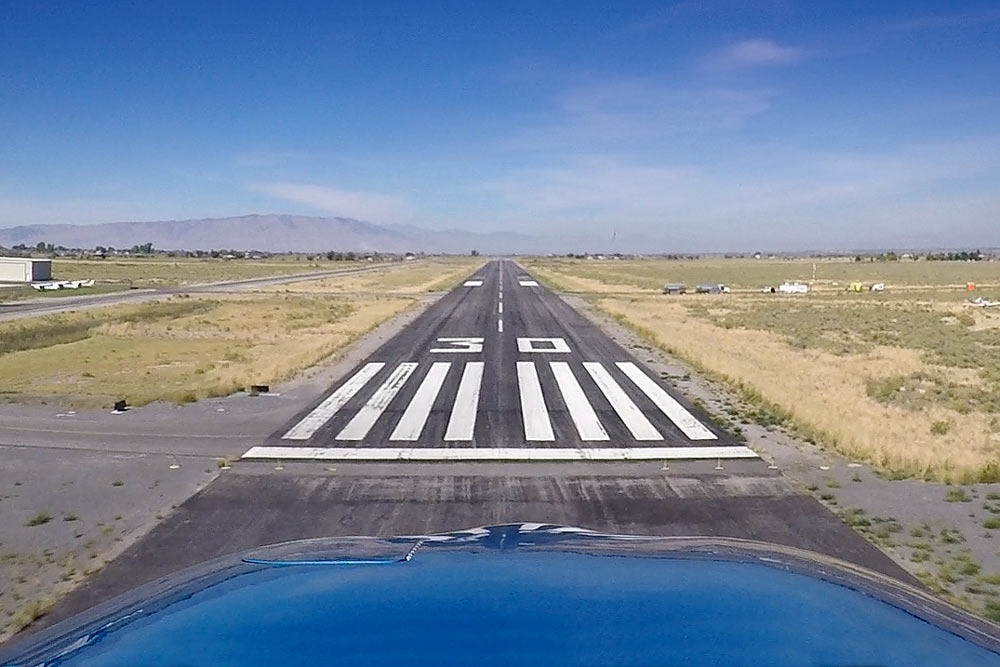I am working on my CFI. Now that I am having to explain while I fly I am having trouble finding the words that suite the actions. I am ironing out my deficiencies one at a time but I am stunningly unable to explain one aspect of landings. This applies to a 1980 C172P.
For a normal landing, the procedure I use, starting from the downwind is:
1. Abeam touchdown point (lets use the 1000' markers), power to 1600 (it will settle at 1500) and flaps 10 once under 110 knots.
2. Maintain altitude with pitch until airspeed gets to 85 knots and then lower the pitch to maintain 85 knots and begin descending.
3. After about 200 feet of descent, look back and verify being approximately 45 degrees off your touchdown point and begin turn to base.
4. Roll into a 30 degree banked turn and slightly lower the nose to maintain 85 knots.
5. Roll out on base (with a wind correction if necessary) and lower the flaps to 20 and pitch up for 75 knots.
6. Ensure the extended final and opposite base leg are clear.
7. When coming up to the final approach course, begin turning at a 30 degree bank while maintaining 75 knots.
8. Roll out on final approximately 400-500 ft AGL, lower the flaps to 30 and pitch for 65 knots.
9. Hold this configuration and maintain 65 knots with pitch and manage descent angle with power until ready to round out. Apply side slip as necessary. Adjust descent angle so that your aiming point is about 200 feet before your touchdown point.
10. Begin rounding out about 100 feet before your aiming point (so 300 feet before your touchdown point) by reducing the power to idle and start pitching up only enough to arrest your descent.
11. Hold the airplane off the runway as long as possible so that you touch down just above stall speed.
The problem I am having is between steps 9 and 10. I know that we don't normally hold approach speed all the way until round out because that will result in too long of a float down the runway. When do you all normally start reducing speed from final approach to the roundout and how would you explain that procedure? What I am concerned about is an examiner claiming that a student slowing down too early can be considered as not maintaining approach speed during final. At what point does the final approach end so that the final approach speed is no longer applicable?
If you notice any other mistakes or room for improvement in the above process I would certainly take the feedback. Thanks.
For a normal landing, the procedure I use, starting from the downwind is:
1. Abeam touchdown point (lets use the 1000' markers), power to 1600 (it will settle at 1500) and flaps 10 once under 110 knots.
2. Maintain altitude with pitch until airspeed gets to 85 knots and then lower the pitch to maintain 85 knots and begin descending.
3. After about 200 feet of descent, look back and verify being approximately 45 degrees off your touchdown point and begin turn to base.
4. Roll into a 30 degree banked turn and slightly lower the nose to maintain 85 knots.
5. Roll out on base (with a wind correction if necessary) and lower the flaps to 20 and pitch up for 75 knots.
6. Ensure the extended final and opposite base leg are clear.
7. When coming up to the final approach course, begin turning at a 30 degree bank while maintaining 75 knots.
8. Roll out on final approximately 400-500 ft AGL, lower the flaps to 30 and pitch for 65 knots.
9. Hold this configuration and maintain 65 knots with pitch and manage descent angle with power until ready to round out. Apply side slip as necessary. Adjust descent angle so that your aiming point is about 200 feet before your touchdown point.
10. Begin rounding out about 100 feet before your aiming point (so 300 feet before your touchdown point) by reducing the power to idle and start pitching up only enough to arrest your descent.
11. Hold the airplane off the runway as long as possible so that you touch down just above stall speed.
The problem I am having is between steps 9 and 10. I know that we don't normally hold approach speed all the way until round out because that will result in too long of a float down the runway. When do you all normally start reducing speed from final approach to the roundout and how would you explain that procedure? What I am concerned about is an examiner claiming that a student slowing down too early can be considered as not maintaining approach speed during final. At what point does the final approach end so that the final approach speed is no longer applicable?
If you notice any other mistakes or room for improvement in the above process I would certainly take the feedback. Thanks.
Last edited:

